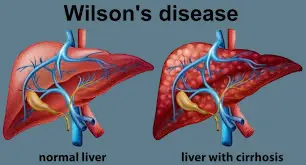
Table of Contents
Living with Wilson’s Illness presents extraordinary difficulties; however, with legitimate administration and understanding, people can lead sound and satisfying lives.
Wilson’s Disease is an uncommon hereditary problem portrayed by the body’s failure to wipe out overabundant copper, prompting unsafe gatherings in fundamental organs like the liver and cerebrum.
This may lead to various symptoms, including liver disease, neurological conditions, and mental health problems. Early conclusions and treatment are urgent in alleviating the potential harm brought about by copper development.
This guide expects to provide exhaustive data and down-to-earth guidance for dealing with Wilson’s Sickness, from understanding the condition’s hidden components to investigating therapy choices and way-of-life changes.
Following a very organized administration plan and keeping up with open correspondence with medical services suppliers, those impacted by Wilson’s Infection can limit side effects and improve their satisfaction.
Whether you are recently determined or have been living with the condition for quite a long time, this guide offers essential knowledge and support to assist you with exploring the intricacies of Wilson’s Sickness.
What Essential Effects Does Wilson’s Disease Have?

The symptoms of Wilson’s sickness can vary comprehensively depending upon which organs are influenced by copper assortment. The liver and the mind typically feel the most impact.
Due to liver damage, early symptoms may include exhaustion, jaundice, and stomach pain. Neurological aftereffects like shakes, inconvenient talking, and coordination issues could be cultivated for a long time.
Typical signs and side effects of psychological instability incorporate emotional episodes, wretchedness, and character shifts.
Specific individuals have a Kayser-Fleischer ring, which is a copper-shaded ring around the cornea.
This ring demonstrates that there are copper stores in the eyes. Since these auxiliary impacts can reflect different circumstances, Wilson’s Disease is often misdiagnosed or explored late.
Recognizing the significant effects early is essential for effective treatment and intervention.
If you or someone you know experiences these secondary effects, it is necessary to direct a clinical consideration capable of genuine testing and determination.
Early recognition can further develop results and forestall complex issues.
How Might Wilson’s Sickness Be Analysed?

Diagnosing Wilson’s Sickness involves clinical assessment, lab tests, and, occasionally, hereditary testing.
At first, a medical care supplier will evaluate the patient’s clinical history and side effects, like liver brokenness or neurological issues.
Blood tests then measure the protein levels that bind copper and ceruloplasmin; low levels might show Wilson’s Sickness.
Additionally, copper excretion, which is typically elevated in affected individuals, is measured by 24-hour urine collection tests.
A liver biopsy may likewise be performed to evaluate copper collection in liver tissue straightforwardly.
Genetic testing can sometimes find ATP7B gene mutations that cause the disorder. Imaging studies like MRIs can also reveal brain abnormalities linked to the disease.
Since side effects can vary depending on the circumstances, it’s fundamental for patients associated with Wilson’s Sickness to undergo a careful indicative cycle.
Early and precise determination is significant for starting treatment and forestalling irreversible harm to organs like the liver and mind.
What options are available for treating Wilson’s Illness?

Therapy for Wilson’s Infection is based on reducing the body’s copper levels and hindering further gathering.
The fundamental philosophy incorporates chelating trained professionals, like penicillamine or trientine, which bind to copper and help release it through pee.
Another decision is zinc treatment, which reduces copper maintenance in the assimilation plots. To restrict copper confirmation, patients are occasionally urged to avoid copper-rich food sources, including shellfish, nuts, and chocolate.
Standard monitoring of copper levels and liver capacity, particularly if liver damage progresses, is essential when changing treatment plans.
Adherence to suggested medicines is essential for regulating aftereffects and hindering disarrays. With early findings and natural therapy, individuals with Wilson’s Disorder can have solid and valuable presences.
How Can Diet and Lifestyle Changes Manage Wilson’s Disease?

Changes to diet and lifestyle play a crucial role in treating Wilson’s disease by helping to regulate copper levels in the body.
One fundamental dietary change involves avoiding food sources. Patients are similarly urged to avoid using copper cookware, which can channel copper into food.
Supplementing clinical medications, such as zinc treatment, chelating specialists, and a low-copper diet, can reduce the risk of copper development in organs.
Maintaining a solid way of life and rolling out dietary improvements are fundamental. While traditional activities can improve overall health and wealth, consulting a physician before beginning any new wellness program is essential.
Stress management techniques like yoga or contemplation can also be beneficial because stress can exacerbate side effects.
It is fundamental to maintain regular subsequent meet-ups with medical care suppliers to screen copper levels and liver capability.
Changes to one’s diet and way of life can help Wilson’s patients manage side effects and improve their satisfaction.
What Are the Long-Term Wilson’s Disease Strategies?

In the long term, the leaders of Wilson’s Disease incorporate a couple of basic frameworks to ensure feasible control of the condition and prevent its complications.
Take your medications as prescribed, chelating trained professionals (like penicillamine or trientine), and use zinc treatment to help coordinate copper levels.
Through blood and liver capability tests, regular checking empowers brief treatment changes and the early discovery of likely issues.
Dietary changes are dire. Patients should avoid copper-rich food sources like shellfish, nuts, and chocolate, and sans-copper cookware should be utilized to diminish copper consumption.
Besides, keeping a fair, regular eating and a sound lifestyle can help people thrive daily.
To keep track of progress and make any necessary adjustments to the management plan.
By tutoring patients about the disease and its secondary effects, leaders draw patients to play a working role in their prosperity.
By combining these approaches, Wilson’s disease sufferers can effectively.
FAQ’s
What is the leading cause of Wilson’s disease?
The essential driver of Wilson’s Disorder is a genetic change in the ATP7B quality that weakens copper processing.
What is the best treatment for Wilson’s infection?
The best treatment for Wilson’s Illness commonly includes long-term utilization of chelating agents like penicillamine or trientine and occasionally zinc treatment to oversee copper levels in the body.
What is the future of Wilson infection?
People with Wilson’s disease may live to an average age with the proper treatment.
Who has a higher risk of developing Wilson’s disease?
Wilson’s Illness is bound to happen in people with a family background of the condition because of its hereditary nature, explicitly in individuals who acquire two changed duplicates of the ATP7B quality.
The Last Note
A genetic condition known as Wilson’s Disease causes. Please remember the following text: “Excessive copper accumulation in the body, particularly in the.” brain and liver.
Much of the time, it causes liver sickness, neurological side effects, and mental issues. Early conclusion and prolonged-lasting administration are essential for forestalling severe medical conditions.

